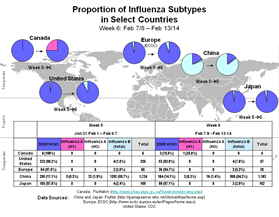2009 H1N1 Flu: International Situation Update
February 26, 2010, 4:00 PM ET
This report provides an update to the international situation using data collected through February 21, 2010, and reported by the World Health Organization (WHO) on February 26. WHO continues to report laboratory-confirmed 2009 H1N1 flu cases and deaths on its Web page. These laboratory-confirmed cases represent a substantial underestimation of total cases in the world, as most countries focus surveillance and laboratory testing only on people with severe illness.
Based on FluNet data collected by 32 countries from February 6 - 13, 2010, 48.3% of specimens testing positive for influenza were typed as influenza A and 51.7% as influenza B. In nearly all countries of the world where influenza infection is reported, the 2009 H1N1 influenza virus continues to predominate among all subtyped influenza A viruses. Out of all subtyped influenza A viruses, 90% were 2009 H1N1 positive.
Little flu activity has been reported in the temperate regions of the Southern Hemisphere in 2010 to date. In the temperate regions of the Northern Hemisphere, the 2009 H1N1 influenza virus continues to be detected across many countries. However, influenza activity continues to decline or remain low in most countries. In the Americas, both in the tropical and northern temperate regions, 2009 H1N1 continues to circulate at low levels, but overall influenza activity continues to decline or remain low in most places. In tropical regions of Asia, several countries reported an increasing trend of influenza activity, but overall intensity remains low. The most active areas of influenza transmission are currently in parts of South and Southeast Asia and in certain areas of East and Southeastern Europe.
Selected Highlights
- According to WHO, the majority of 2009 H1N1 influenza isolates tested worldwide remain sensitive to oseltamivir, an antiviral medicine used to treat influenza disease. Among 2009 H1N1 isolates tested worldwide, 253 have been found to be resistant to oseltamivir – 60 of these isolates were detected in the United States.
- Influenza B activity continues to increase in China and Hong Kong Special Administrative Region (SAR) of China. Hong Kong SAR China has reported increased influenza B activity accounting for 56.1% of all influenza detections, while in China it accounted for 83.5%. In addition to the increasing proportion of influenza type B viruses detected in China, low levels of seasonal influenza A (H3N2) and type B viruses are circulating in parts of Africa and Asia.
- As of February 18, 2010, WHO has published recommendations for the following viruses to be used for influenza vaccines in the 2010-2011 influenza season of the Northern Hemisphere:
- an A/California/7/2009 (H1N1)-like virus;
- an A/Perth/16/2009 (H3N2)-like virus*;
- a B/Brisbane/60/2008-like virus.
* A/Wisconsin/15/2009 is an A/Perth/16/2009 (H3N2)-like virus and is
2010 Southern Hemisphere vaccine virus.
International Resources for 2009 H1N1 Information
Health Organizations
- World Health Organization (WHO)
- ECDC (European Centre for Disease Prevention and Control)
- H2P (Humanitarian Pandemic Preparedness)
- Public Health Agency of Canada
World Health Organization (WHO) Regional Offices
- AFRO (WHO Regional Office for Africa)
- AMRO (WHO Regional Office for the Americas) / PAHO (Pan American Health Organization)
- EMRO (WHO Regional Office for the Eastern Mediterranean)
- EURO (WHO Regional Office for Europe)
- SEARO (WHO Regional Office for South-East Asia)
- WPRO (WHO Regional Office for the Western Pacific)
Travel and 2009 H1N1 Flu
Human cases of 2009 H1N1 flu virus infection have been identified in the United States and several countries around the world. For information on 2009 H1N1 flu and travel, see the CDC H1N1 Flu and Travel website.
Reports and Publications
- White House Report on 2009 H1N1 in the Southern Hemisphere
Issued August 2009 – This White House report was prepared by the Department of Health and Human Services (HHS) in coordination with the Office of the Director for National Intelligence (ODNI) and the Department of State (Dos) and describes the characteristics and impact of 2009 H1N1 influenza A virus in the Southern Hemisphere. - ECDC Interim Risk Assessment Influenza A (H1N1) 2009 Pandemic
Issued July 30, 2009 - This document provides an interim risk assessment of novel H1N1 flu in Europe prepared by ECDC. - World Health Organization Weekly Epidemiological record – Issued July 24, 2009
This document by WHO provides updates on the international novel H1N1 flu situation. - MMWR – Update: Novel Influenza A (H1N1) Virus Infection – Mexico, March-May, 2009 – Issued June 5, 2009 / Vol. 58 / No. 21.
This Morbidity and Mortality Weekly Report describes the novel influenza A (H1N1) outbreak in Mexico from March-May, 2009. - MMWR – Update: Novel Influenza A (H1N1) Virus Infections – Worldwide, May 6, 2009 – Issued May 8, 2009 / Vol. 58 / No. 17.
This Morbidity and Mortality Weekly Report describes worldwide novel influenza A (H1N1) infections as of May 6, 2009.
Get email updates
To receive weekly email updates about this site, enter your email address:
Contact Us:
- Centers for Disease Control and Prevention
1600 Clifton Rd
Atlanta, GA 30333 - 800-CDC-INFO
(800-232-4636)
TTY: (888) 232-6348 - Contact CDC-INFO
